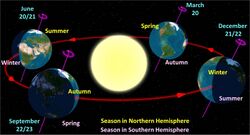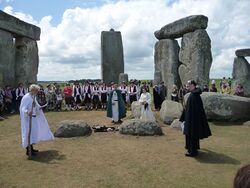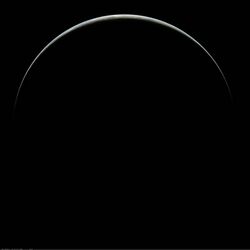Summer solstice
Topic: Astronomy
 From HandWiki - Reading time: 4 min
From HandWiki - Reading time: 4 min
| event | equinox | solstice | equinox | solstice | ||||
|---|---|---|---|---|---|---|---|---|
| month | March | June | September | December | ||||
| year | day | time | day | time | day | time | day | time |
| 2019 | 20 | 21:58 | 21 | 15:54 | 23 | 07:50 | 22 | 04:19 |
| 2020 | 20 | 03:50 | 20 | 21:43 | 22 | 13:31 | 21 | 10:03 |
| 2021 | 20 | 09:37 | 21 | 03:32 | 22 | 19:21 | 21 | 15:59 |
| 2022 | 20 | 15:33 | 21 | 09:14 | 23 | 01:04 | 21 | 21:48 |
| 2023 | 20 | 21:25 | 21 | 14:58 | 23 | 06:50 | 22 | 03:28 |
| 2024 | 20 | 03:07 | 20 | 20:51 | 22 | 12:44 | 21 | 09:20 |
| 2025 | 20 | 09:02 | 21 | 02:42 | 22 | 18:20 | 21 | 15:03 |
| 2026 | 20 | 14:46 | 21 | 08:25 | 23 | 00:06 | 21 | 20:50 |
| 2027 | 20 | 20:25 | 21 | 14:11 | 23 | 06:02 | 22 | 02:43 |
| 2028 | 20 | 02:17 | 20 | 20:02 | 22 | 11:45 | 21 | 08:20 |
| 2029 | 20 | 08:01 | 21 | 01:48 | 22 | 17:37 | 21 | 14:14 |
The summer solstice or estival solstice[lower-roman 1] occurs when one of Earth's poles has its maximum tilt toward the Sun. It happens twice yearly, once in each hemisphere (Northern and Southern). For that hemisphere, the summer solstice is the day with the longest period of daylight and shortest night of the year, when the Sun is at its highest position in the sky. At either pole there is continuous daylight at the time of its summer solstice. The opposite event is the winter solstice.
The summer solstice occurs during the hemisphere's summer. In the Northern Hemisphere, this is the June solstice (20 or 21 June) and in the Southern Hemisphere, this is the December solstice (21 or 22 of December). Since prehistory, the summer solstice has been a significant time of year in many cultures, and has been marked by festivals and rituals. Traditionally, in temperate regions (especially Europe), the summer solstice is seen as the middle of summer and referred to as midsummer; although today in some countries and calendars it is seen as the beginning of summer.
On the summer solstice, Earth's maximum axial tilt toward the Sun is 23.44°.[3] Likewise, the Sun's declination from the celestial equator is 23.44°.

Although the summer solstice is the longest day of the year for that hemisphere, the dates of earliest sunrise and latest sunset vary by a few days.[4] This is because Earth orbits the Sun in an ellipse, and its orbital speed varies slightly during the year.[3]
Culture

There is evidence that the summer solstice has been culturally important since the Neolithic era. Many ancient monuments in Europe especially, as well as parts of the Middle East, Asia and the Americas, are aligned with the sunrise or sunset on the summer solstice (see archaeoastronomy).[5][6] The significance of the summer solstice has varied among cultures, but most recognize the event in some way with holidays, festivals, and rituals around that time with themes of fertility.[7] In the Roman Empire, the traditional date of the summer solstice was 24 June.[8] In Germanic-speaking cultures, the time around the summer solstice is called 'midsummer'. Traditionally in northern Europe midsummer was reckoned as the night of 23–24 June, with summer beginning on May Day.[9] The summer solstice continues to be seen as the middle of summer in many European cultures, but in some cultures or calendars it is seen as summer's beginning.[10] In Sweden, midsummer is one of the year's major holidays when the country closes down as much as during Christmas.
Observances
- Traditional festivals
- Saint John's Eve (Europe), including:
- Jaanipäev (Estonia)
- Jāņi (Latvia)
- Joninės (Lithuania)
- Jónsmessa (Iceland)
- Golowan (Cornwall)
- Kupala Night (Slavic peoples)
- Yhyakh (Yakuts)
- Tiregān (Iran)
- Xiazhi (China)
- Modern observances
- National Indigenous Peoples Day (Canada )
- Day of Private Reflection (Northern Ireland)
- Fremont Solstice Parade (Fremont, Seattle, Washington, United States )
- Santa Barbara Summer Solstice Parade (Santa Barbara, California, United States )
- International Yoga Day
- Fête de la Musique, also known as World Music Day
Length of the day on northern summer solstice
The length of day increases from the equator towards the North Pole in the Northern Hemisphere in June (around the summer solstice there), but decreases towards the South Pole in the Southern Hemisphere at the time of the southern winter solstice.
Notes
- ↑ Also aestival solstice in British English. From Latin aestīvus, 'summer'.
References
- ↑ United States Naval Observatory (January 4, 2018). "Earth's Seasons and Apsides: Equinoxes, Solstices, Perihelion, and Aphelion". http://aa.usno.navy.mil/data/docs/EarthSeasons.php. [|permanent dead link|dead link}}]
- ↑ "Solstices and Equinoxes: 2001 to 2100". February 20, 2018. http://www.astropixels.com/ephemeris/soleq2001.html.
- ↑ 3.0 3.1 "The Long Story (USNO explanation)". http://aa.usno.navy.mil/faq/docs/rs_solstices.php#long.
- ↑ "US Naval Observatory: Sunrise and Sunset Times Near the Solstices". http://aa.usno.navy.mil/faq/docs/rs_solstices.php.
- ↑ Papadopoulos, Costas; Moyes, Holley, eds (2021). The Oxford Handbook of Light in Archaeology. Oxford University Press.
- ↑ Kelley, David; Milone, Eugene (2005). Exploring Ancient Skies: An Encyclopedic Survey of Archaeoastronomy. Springer Publishing.
- ↑ "Summer solstice celebrations of Christianity, Judaism, Neopaganism, etc". Religioustolerance.org. http://www.religioustolerance.org/summer_solstice.htm.
- ↑ O'Neill, William Matthew (1976). Time and the Calendars. Manchester University Press. p. 85.
- ↑ Harper, Douglas. "midsummer". Online Etymology Dictionary. https://www.etymonline.com/?term=midsummer. Retrieved 2023-06-22.
- ↑ "The Astronomical vs. Meteorological Seasons". http://weather.about.com/od/climatechange/fl/Astronomical-vs-Meteorological-Seasons.htm.
External links
- SummerSolstice.uk - Summer Solstice Dates, Information & Community.
- NeoProgrammics - Table of Northern/Southern Solstice Dates/Times From 1600–2400
de:Sonnenwende#Sommersonnenwende
 |
 KSF
KSF
